
Rococo, less commonly Roccoco, also known as Late Baroque, is an exceptionally ornamental and dramatic style of architecture, art and decoration which combines asymmetry, scrolling curves, gilding, white and pastel colours, sculpted moulding, and trompe-l'œil frescoes to create surprise and the illusion of motion and drama. It is often described as the final expression of the Baroque movement.
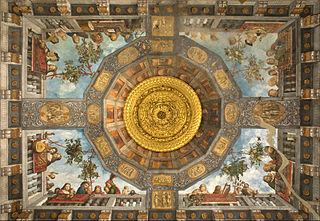
Trompe-l'œil is an artistic term for the highly realistic optical illusion of three-dimensional space and objects on a two-dimensional surface. Trompe l'œil, which is most often associated with painting, tricks the viewer into perceiving painted objects or spaces as real. Forced perspective is a related illusion in architecture.

Queen's House is a former royal residence in the London borough of Greenwich, which presently serves as a public art gallery. It was built between 1616 and 1635 on the grounds of the now demolished Greenwich Palace, a few miles downriver from the City of London. In its current setting, it forms a central focus of the Old Royal Naval College with a grand vista leading to the River Thames, a World Heritage Site called, Maritime Greenwich. The Queen's House architect, Inigo Jones, was commissioned by Queen Anne of Denmark in 1616 and again to finish the house in 1635 by Queen Henrietta Maria. The House was commissioned by both Anne and Henrietta as a retreat and place to display and enjoy the artworks they had accumulated and commissioned; this includes a ceiling of the Great Hall that features a work by Orazio Gentileschi titled Allegory of Peace and the Arts.
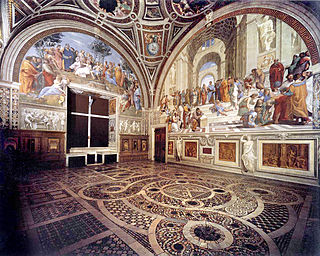
In art history, the High Renaissance was a short period of the most exceptional artistic production in the Italian states, particularly Rome, capital of the Papal States, and in Florence, during the Italian Renaissance. Most art historians state that the High Renaissance started between 1490 and 1500, and ended in 1520 with the death of Raphael, although some say the High Renaissance ended about 1525, or in 1527 with the Sack of Rome by the mutinous army of Charles V, Holy Roman Emperor, or about 1530. The best-known exponents of painting, sculpture and architecture of the High Renaissance include Leonardo da Vinci, Michelangelo, Raphael, and Bramante. In the 21st century, the use of the term has been frequently criticized by some academic art historians for oversimplifying artistic developments, ignoring historical context, and focusing only on a few iconic works.

Stucco or render is a construction material made of aggregates, a binder, and water. Stucco is applied wet and hardens to a very dense solid. It is used as a decorative coating for walls and ceilings, exterior walls, and as a sculptural and artistic material in architecture. Stucco can be applied on construction materials such as metal, expanded metal lath, concrete, cinder block, or clay brick and adobe for decorative and structural purposes.

Jacob de Wit was a Dutch artist and interior decorator who painted many religious scenes.

A coffer in architecture is a series of sunken panels in the shape of a square, rectangle, or octagon in a ceiling, soffit or vault. A series of these sunken panels was often used as decoration for a ceiling or a vault, also called caissons ("boxes"), or lacunaria, so that a coffered ceiling can be called a lacunar ceiling: the strength of the structure is in the framework of the coffers.
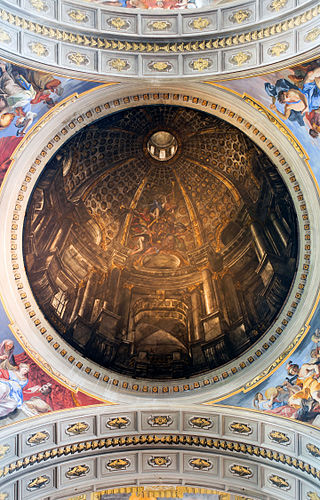
Illusionistic ceiling painting, which includes the techniques of perspective di sotto in sù and quadratura, is the tradition in Renaissance, Baroque and Rococo art in which trompe-l'œil, perspective tools such as foreshortening, and other spatial effects are used to create the illusion of three-dimensional space on an otherwise two-dimensional or mostly flat ceiling surface above the viewer. It is frequently used to create the illusion of an open sky, such as with the oculus in Andrea Mantegna's Camera degli Sposi, or the illusion of an architectural space such as the cupola, one of Andrea Pozzo's frescoes in Sant'Ignazio, Rome. Illusionistic ceiling painting belongs to the general class of illusionism in art, designed to create accurate representations of reality.

Pushkinskaya is a station on Moscow Metro's Tagansko-Krasnopresnenskaya Line. Opened on 17 December 1975, along with Kuznetsky Most as the segment which linked the Zhdanovskaya and Krasnopresnenskaya Lines into one. Like its neighbour, the station was a column tri-vault type, which had not been seen in Moscow since the 1950s. Arguably the most beautiful station on the Line, the architects Vdovin and Bazhenov took every effort to make it appear to have a 'classical' 19th century setting. The central hall lighting is created with stylised 19th century chandeliers with two rows of plafonds appearing like candles, while the side platforms have candlesticks with similar plafonds. The columns, covered with 'Koelga' white marble are decorated with palm leaf reliefs and the grey marble walls are decorated with brass measured insertions based on the works of the great Russian poet Alexander Pushkin. The grey granite floor completes the appearance of the masterpiece. Architecturally the station put the final stop to the functionality economy design of the 1960s and went against Nikita Khrushchev's policy of struggle to avoid decorative 'extras', which left the stations of 1958–59 greatly altered in their design.
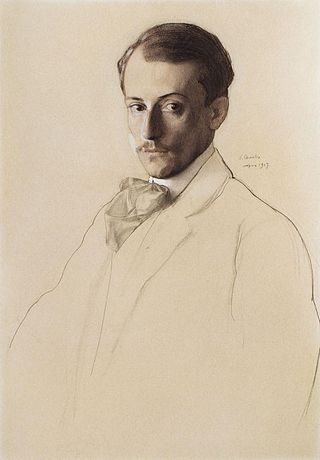
Yevgeny Yevgenyevich Lanceray, also often spelled Eugene Lansere, was a Russian graphic artist, painter, sculptor, mosaicist, and illustrator, associated stylistically with Mir iskusstva.
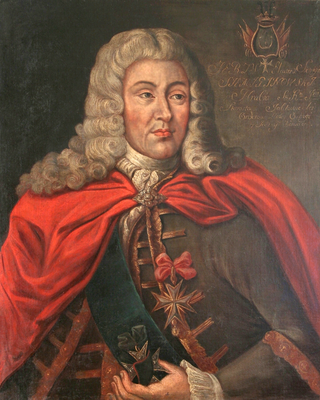
Jerzy Siemiginowski-Eleuter was a prominent Polish painter and engraver of the Baroque era. He was court painter to king John III Sobieski and a Polish–Lithuanian noble. He is considered one of the most accomplished painters of Classical Baroque in Poland. His works combine the classical approach with native elements.

The Palace on the Isle, also known as the Baths Palace, is a classicist palace in Warsaw's Royal Baths Park, the city's largest park, occupying over 76 hectares of the city center.
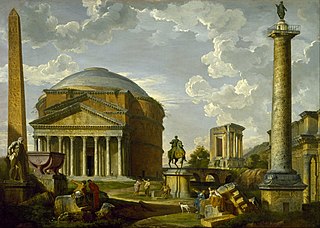
In painting, a capriccio is an architectural fantasy, placing together buildings, archaeological ruins and other architectural elements in fictional and often fantastical combinations. These paintings may also include staffage (figures). Capriccio falls under the more general term of landscape painting. This style of painting was introduced in the Renaissance and continued into the Baroque.
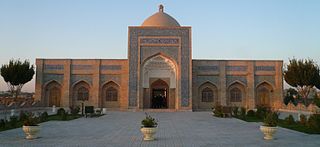
Bahoutdin Architectural Complex is a complex in Bukhara, Uzbekistan, that includes the tomb of Baha-ud-Din Naqshband Bukhari, the founder of the Naqshbandi order, who died in 1389. The ancient name of the location was Kasri Arifon.

The Lescot Wing is the oldest preserved structure above ground of the Louvre Palace in Paris, France. It was designed by architect Pierre Lescot and built between 1546 and 1551. Its architecture is influenced by Italian Mannerism. It had seminal influence on what became the Parisian Renaissance style, and beyond it, French architectural classicism.
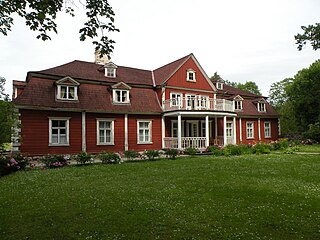
Ungurmuiža Manor is a manor house in the historical region of Vidzeme, in northern Latvia. The estate is named for the von Ungern family, who owned it prior to the middle of the 17th century. The current wooden manor was built in 1731–1732 in Baroque style for the owner, Lieutenant General Balthasar Freiherr von Campenhausen. The von Campenhausen family owned the estate from 1728 to 1939. Ungurmuiža manor was one of those manors which was not nationalised in Latvian agrarian reforms of the 1920s. Despite its quite small size, manor is elegant construction with richest wall paintings and ceiling plafonds of Baroque age in Vidzeme region.

Teruel Cathedral or Catedral de Santa María de Mediavilla de Teruel is a Roman Catholic church in Teruel, Aragon, Spain. Dedicated to St. Mary, it is a notable example of Mudéjar architecture. Together with other churches in the town and in the province of Zaragoza, it has been listed as a UNESCO World Heritage Site since 1986.

The Rouffignac cave, in the French commune of Rouffignac-Saint-Cernin-de-Reilhac in the Dordogne département, contains over 250 engravings and cave paintings dating back to the Upper Paleolithic. In conjunction with other caves and abris of the Vézère valley, the Rouffignac cave was classified a Monument historique in 1957 and a World Heritage Site in 1979 by UNESCO as part of the Prehistoric Sites and Decorated Caves of the Vézère Valley.

The Palace of the Kraków Bishops in Kielce, was built in the 17th century as a summer residence of bishops of Kraków in Kielce, Poland. The architecture of the palace constitutes a unique mélange of Polish and Italian traditions and reflects political ambitions of its founder. Currently the palace houses a branch of the National Museum with an important gallery of Polish paintings.

The Mehmandarovs' House is a historic palace-type residential complex located in Shusha. It is one of the most interesting examples of the 18th century's civil architecture of Azerbaijan. The residential complex, which originally belonged to the Armenian Lieutenant Yesai Gharamyants during the 19th century, came into the possession of the Mehmandarov family in 1918. It includes the Large Residential Building, the Small Residential Building and the Family Mosque. The complex is fenced with stone walls. It was previously the site of the Shusha Museum of History.




















